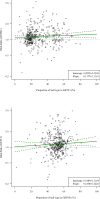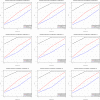Epistasis Test in Meta-Analysis: A Multi-Parameter Markov Chain Monte Carlo Model for Consistency of Evidence
- PMID: 27045371
- PMCID: PMC4821560
- DOI: 10.1371/journal.pone.0152891
Epistasis Test in Meta-Analysis: A Multi-Parameter Markov Chain Monte Carlo Model for Consistency of Evidence
Abstract
Conventional genome-wide association studies (GWAS) have been proven to be a successful strategy for identifying genetic variants associated with complex human traits. However, there is still a large heritability gap between GWAS and transitional family studies. The "missing heritability" has been suggested to be due to lack of studies focused on epistasis, also called gene-gene interactions, because individual trials have often had insufficient sample size. Meta-analysis is a common method for increasing statistical power. However, sufficient detailed information is difficult to obtain. A previous study employed a meta-regression-based method to detect epistasis, but it faced the challenge of inconsistent estimates. Here, we describe a Markov chain Monte Carlo-based method, called "Epistasis Test in Meta-Analysis" (ETMA), which uses genotype summary data to obtain consistent estimates of epistasis effects in meta-analysis. We defined a series of conditions to generate simulation data and tested the power and type I error rates in ETMA, individual data analysis and conventional meta-regression-based method. ETMA not only successfully facilitated consistency of evidence but also yielded acceptable type I error and higher power than conventional meta-regression. We applied ETMA to three real meta-analysis data sets. We found significant gene-gene interactions in the renin-angiotensin system and the polycyclic aromatic hydrocarbon metabolism pathway, with strong supporting evidence. In addition, glutathione S-transferase (GST) mu 1 and theta 1 were confirmed to exert independent effects on cancer. We concluded that the application of ETMA to real meta-analysis data was successful. Finally, we developed an R package, etma, for the detection of epistasis in meta-analysis [etma is available via the Comprehensive R Archive Network (CRAN) at https://cran.r-project.org/web/packages/etma/index.html].
Conflict of interest statement
Figures



References
MeSH terms
Substances
LinkOut - more resources
Full Text Sources
Other Literature Sources
Research Materials
Miscellaneous

